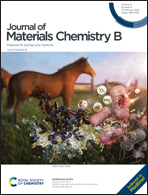Cross-linked (R)-(+)-lipoic acid nanoparticles with prodrug loading for synergistic cancer therapy†
Abstract
The nonspecific toxicity of loaded drugs and the side effect of carriers are two obstacles that hinder the clinical development of anticancer nanodrugs. Herein, we developed a new nanodrug 3-(methylthio)-propanoate camptothecin (Pro-CPT) loaded with cross-linked (R)-(+)-lipoic acid nanoparticles (Pro-CPT@cLANs). The Pro-CPT is a pH-responsive prodrug of camptothecin (CPT) that can effectively reduce the systemic toxicity of CPT caused by premature release. The cLANs are nanoparticles with structural homology to (R)-(+)-lipoic acid (LA) that hold not only LA-like biocompatibility but also LA-like anticancer activity, which may further relieve the toxicity of loaded drugs by reducing their dosages through synergistic effects and precise drug release at the tumor sites. According to in vitro data, the ICPro-CPT50 of Pro-CPT@cLANs against HT29 cells was 0.12 μM, ∼2.5 times lower than that of free Pro-CPT (0.3 μM); in vivo data showed that the tumor inhibition rate (TIR) and survival rate (SR) of Pro-CPT@cLANs against HT29 tumor-bearing nude mice were up to 85.1% and 80%, respectively, also far better than those of free CPT at the same dosage (TIR: 46%, SR: 0%). The Pro-CPT@cLANs provide a simple and efficient strategy to surmount the two obstacles in the development of nanodrugs and hold potential in clinical utility.



 Please wait while we load your content...
Please wait while we load your content...